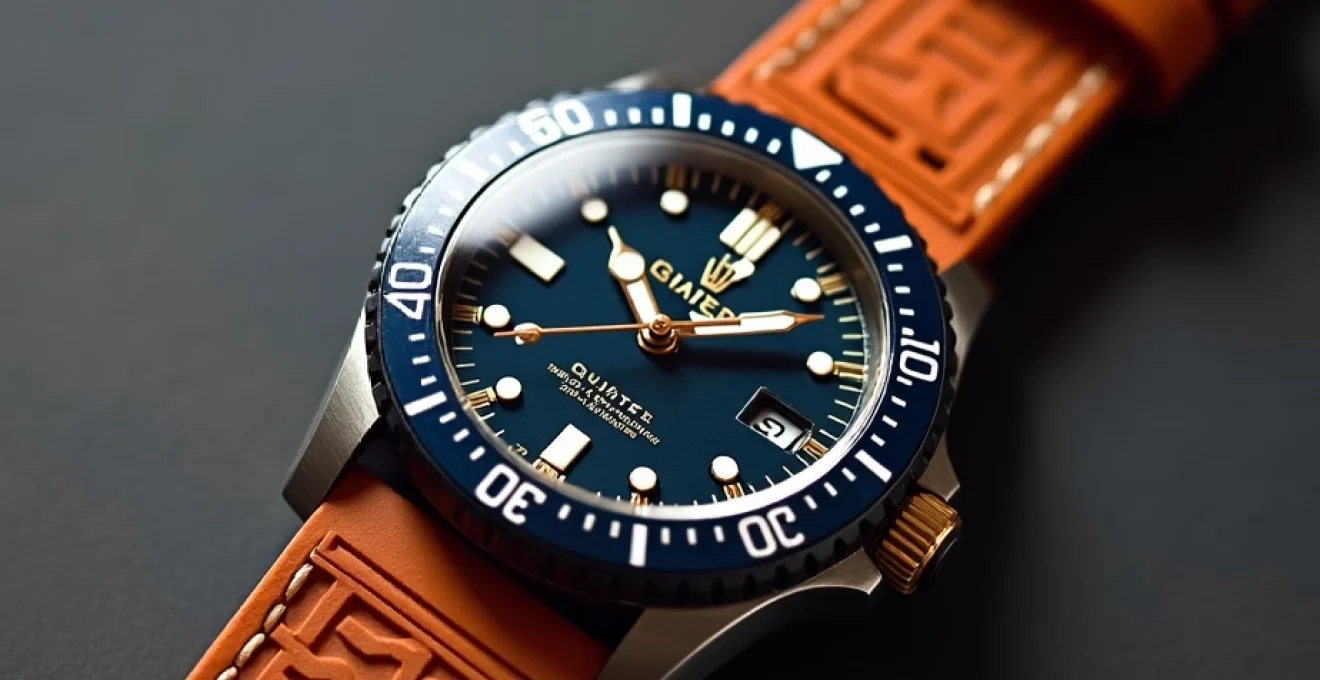
Luxury timepieces deserve straps that match their quality and sophistication. While leather and metal bracelets have long been the go-to choices, rubber watch straps have emerged as a stylish and practical alternative. These versatile accessories offer a perfect blend of durability, comfort, and aesthetic appeal, making them an excellent option for watch enthusiasts looking to elevate their timepiece’s look and functionality.
Rubber straps have come a long way from their humble beginnings as purely utilitarian components. Today, they are engineered with advanced materials and designed with meticulous attention to detail, catering to the discerning tastes of watch connoisseurs. Whether you’re an avid diver, a fitness enthusiast, or simply someone who appreciates a comfortable and stylish watch, a high-quality rubber strap can transform your timepiece and enhance your overall wearing experience.
Material science of rubber watch straps: durability and performance
The world of rubber watch straps is a fascinating intersection of material science and horological design. Modern rubber straps are far more than simple bands of elastomer; they are carefully engineered products that balance durability, flexibility, and aesthetics. Understanding the materials used in these straps is crucial for appreciating their performance and making informed choices when selecting a strap for your timepiece.
Shore durometer ratings: measuring strap hardness and flexibility
The Shore durometer scale is a crucial metric in understanding the physical properties of rubber watch straps. This scale measures the hardness of rubber materials, which directly correlates to their flexibility and feel on the wrist. Straps with lower Shore ratings are softer and more pliable, while those with higher ratings offer more rigidity and structure.
Most high-quality rubber watch straps fall within the 40A to 70A range on the Shore scale. This sweet spot balances comfort with durability, ensuring the strap remains flexible enough for all-day wear while maintaining its shape and resistance to deformation. When selecting a strap, consider your preferences for softness versus structure to find the perfect balance for your wrist.
UV resistance and color stability in rubber watch straps
One of the key advantages of modern rubber watch straps is their excellent resistance to UV radiation. This feature plays a vital role in preserving both the appearance and structural integrity of the strap over time—especially for individuals who frequently wear their watches outdoors or in sunny environments.
A prime example is the Omega rubber strap, which is crafted using advanced UV-resistant materials designed to prevent fading, discoloration, and deterioration caused by prolonged sun exposure. Thanks to these high-performance compounds, the strap maintains its vibrant color and flexible texture for years.
When choosing a rubber watch strap, opting for a UV-resistant model is essential for ensuring long-term durability, consistent performance, and lasting aesthetic appeal.
Ergonomics and comfort: designing the perfect rubber watch strap
The comfort of a watch strap is paramount to the overall wearing experience. Rubber straps, when designed with ergonomics in mind, can offer unparalleled comfort for extended wear. The best rubber straps are those that seamlessly blend form and function, providing a secure fit while adapting to the natural contours of the wrist.
Ventilation patterns: FKM rubber and moisture management
Advanced rubber straps often incorporate ventilation patterns to enhance comfort during active wear or in warm climates. These patterns, typically consisting of small channels or perforations, allow air to circulate between the strap and the skin, reducing sweat accumulation and preventing the uncomfortable “sticky” feeling often associated with rubber materials.
FKM (Fluoroelastomer) rubber is a premium material increasingly used in high-end watch straps due to its excellent moisture management properties. This synthetic rubber offers superior resistance to oils, sweat, and chemicals, making it an ideal choice for those who lead active lifestyles or work in challenging environments. The inherent properties of FKM rubber, combined with thoughtful ventilation design, result in a strap that remains comfortable and hygienic throughout the day.
Integrated curved-end designs for seamless case integration
One of the hallmarks of a well-designed rubber strap is its ability to integrate seamlessly with the watch case. Curved-end designs are engineered to follow the contours of the watch case, eliminating gaps and creating a cohesive look. This not only enhances the aesthetic appeal of the timepiece but also improves comfort by preventing the strap from catching on clothing or objects.
Integrated designs also contribute to the overall water resistance of the watch, as they minimize spaces where water or debris can accumulate. For dive watches or timepieces intended for aquatic use, this feature is particularly important in maintaining the watch’s performance and longevity.
Quick-release spring bars: tool-free strap changes
The advent of quick-release spring bars has revolutionized the way watch enthusiasts interact with their timepieces. These innovative components allow for tool-free strap changes, enabling users to swap out their rubber straps quickly and easily. This feature is particularly valuable for those who like to change their watch’s look frequently or need to switch between different strap materials for various activities.
Quick-release mechanisms are typically integrated into the strap itself, with small levers or pins that can be manipulated by hand. This design not only saves time but also reduces the risk of scratching the watch case during strap changes, a common concern when using traditional spring bars and tools.
Aesthetic versatility: elevating watch styles with rubber straps
While rubber straps were once considered purely functional, modern designs have elevated them to a status of high fashion. Today’s rubber straps come in a wide array of colors, textures, and finishes, allowing watch enthusiasts to express their personal style and complement their timepieces in unique ways.
Textured surfaces: tropics, waffle, and basketweave patterns
Texture plays a crucial role in the aesthetic appeal of rubber watch straps. Manufacturers have developed a variety of patterns that not only enhance the visual interest of the strap but also serve functional purposes. Some popular textures include:
- Tropic patterns: Inspired by vintage dive watch straps, these feature a distinctive diamond-shaped texture that adds a classic, retro feel to modern timepieces.
- Waffle patterns: Characterized by a grid of small, raised squares, waffle textures provide excellent grip and a sporty aesthetic.
- Basketweave patterns: These intricate designs mimic the look of woven materials, offering a more refined appearance that bridges the gap between casual and formal wear.
These textures not only contribute to the strap’s visual appeal but also can improve its grip on the wrist, especially in wet conditions. When selecting a textured rubber strap, consider how it complements the overall design of your watch and suits your personal style preferences.
Deployant clasps vs. tang buckles: security and adjustability
The choice between a deployant clasp and a traditional tang buckle can significantly impact both the functionality and aesthetics of your rubber watch strap. Each option has its merits, and the best choice often depends on personal preference and the specific requirements of the watch.
Deployant clasps offer enhanced security and convenience, with a folding mechanism that allows for easy wearing and removal of the watch. These clasps distribute tension more evenly across the strap, potentially extending its lifespan. Additionally, they provide a cleaner, more streamlined look when the watch is off the wrist.
Tang buckles, on the other hand, offer simplicity and a classic appearance. They allow for more precise adjustment of the strap length and are often preferred for their ease of use and traditional aesthetic. Some watch enthusiasts appreciate the ritual of fastening a tang buckle, viewing it as part of the experience of wearing a fine timepiece.
Maintenance and longevity: preserving your rubber watch strap
Proper care and maintenance are essential for ensuring the longevity and performance of your rubber watch strap. With the right approach, a high-quality rubber strap can maintain its appearance and functionality for many years, making it a worthwhile investment for any watch enthusiast.
Cleaning protocols: isopropyl alcohol vs. mild soap solutions
Regular cleaning is crucial for maintaining the appearance and hygiene of your rubber watch strap. Two common cleaning methods are using isopropyl alcohol or mild soap solutions. Each has its advantages and is suitable for different types of rubber materials.
Isopropyl alcohol is effective for disinfecting and removing stubborn stains or oils from rubber straps. It evaporates quickly, leaving no residue, and can help restore the strap’s original texture. However, it should be used sparingly, as frequent use may dry out some types of rubber over time.
Mild soap solutions, on the other hand, are gentler and suitable for regular cleaning. They effectively remove dirt and sweat without risking damage to the rubber material. After cleaning with soap, it’s important to rinse the strap thoroughly with clean water to remove any soap residue that could cause skin irritation.
Storage practices: avoiding ozone damage and shape deformation
Proper storage is essential for preserving the quality of your rubber watch strap when it’s not in use. Rubber is susceptible to ozone damage, which can cause cracking and deterioration over time. To protect your strap, store it in a cool, dry place away from direct sunlight and sources of ozone, such as electric motors or air purifiers.
To prevent shape deformation, avoid storing your rubber strap in a tightly coiled or bent position. Instead, lay it flat or use a watch storage box with dedicated compartments. If your strap has a natural curve, store it in a way that maintains this shape to prevent stress on the material.
Strap rotation strategies to extend lifespan
Implementing a strap rotation strategy can significantly extend the lifespan of your rubber watch straps. By alternating between different straps, you reduce the wear and stress on any single strap, allowing each one to “rest” and recover its shape between uses.
Consider rotating between two or three different straps, alternating them based on your activities or the seasons. For example, you might use a more robust, textured strap for summer outdoor activities and switch to a sleeker, smooth strap for cooler months or formal occasions.
Additionally, rotating straps allows you to experiment with different looks and styles, keeping your watch fresh and interesting. This practice not only extends the life of your straps but also enhances your overall enjoyment of your timepiece collection.
